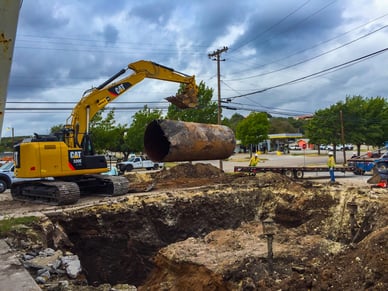Once a decision has been reached to dig up and permanently remove an underground storage tank, it is vital to be aware that both the federal Environmental Protection Agency (EPA) and state entities such as the Texas Commission on Environmental Quality (TCEQ) have very strict regulations on precisely how this eradication must be performed.
Organizational Requirements
The Environmental Protection Agency's regulations pertaining to underground storage tank removal begin with the qualifications of the entity performing the work, and proceed from there to create a web of protections and guidelines aimed at discovering existing contamination, and preventing any new occurrences.
The principal administrative regulations are:
- entities overseeing any underground storage tank removal are required to be licensed by - and registered
 with - state environmental protection agencies – such as the TCEQ
with - state environmental protection agencies – such as the TCEQ - a written removal plan must be submitted to such agencies at least 30 days prior to beginning work
- notification of controlling agency (e.g. TCEQ) and the local fire marshal is required 24 – 72 hours before commencement of work
- rigorous records must be kept detailing the entire removal process. These should include site assessment reports, known earlier substance releases, methods used to handle, transport, store, and dispose of the UST – and more.
These provisions are in-place to assure the basic competency of those carrying out the removal, and the establishment of adequate records to conduct a complete investigation at a later date, should the need arise.
Performance Requirements
Once a properly licensed and registered contractor has been selected to perform the underground storage tank removal, there are also a number of regulatory conditions that must be adhered to which pertain to the actual work process employed. These include:
- emptying the tank of all regulated substances, accumulated sludge, and the purging of all vapors
- collect soil samples and site assessment to determine if contamination is present
- empty, plug and cap tank piping and related equipment
- removal of the UST from the site within 24 hours
- assure that during post-removal storage, no ignition sources are present, and that the storage site prevents unauthorized access to the tank
- marking on the tank a notice alerting to its flammable nature – and warning against using it to store substances designed for human consumption
The bottom line is that underground storage tank removal is a detailed operation that must be carried out in a professional manner in-order to maintain groundwater protections at every step of the process.
The risks of accidentally contaminating soil during an underground storage tank (UST) removal operation – as well as potential hazards to the workers performing the work – are both factors underlying the need for these regulations.
Do you need help with your underground storage tank? If so, contact Talon/LPE today. We will complete the paperwork, perform the removal, and provide regulatory correspondence.

